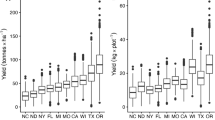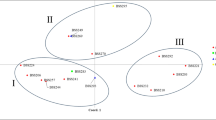Summary
Changes that may have occurred over the past 50 years of hybrid breeding in maize (Zea maize L.) with respect to heterosis for yield and heterozygosity at the molecular level are of interest to both maize breeders and quantitative geneticists. The objectives of this study were twofold: The first, to compare two diallels produced from six older maize inbreds released in the 1950's and earlier and six newer inbreds released during the 1970's with respect to (a) genetic variation for restriction fragment length polymorphisms (RFLPs) and (b) the size of heterosis and epistatic effects, and the second, to evaluate the usefulness of RFLP-based genetic distance measures in predicting heterosis and performance of single-cross hybrids. Five generations (parents, F1; F2, and backcrosses) from the 15 crosses in each diallel were evaluated for grain yield and yield components in four Iowa environments. Genetic effects were estimated from generation means by ordinary diallel analyses and by the Eberhart-Gardner model. Newer lines showed significantly greater yield for inbred generations than did older lines but smaller heterosis estimates. In most cases, estimates of additive x additive epistatic effects for yield and yield components were significantly positive for both groups of lines. RFLP analyses of inbred lines included two restriction enzymes and 82 genomic DNA clones distributed over the maize genome. Eighty-one clones revealed polymorphisms with at least one enzyme. In each set, about three different RFLP variants were typically found per RFLP locus. Genetic distances between inbred lines were estimated from RFLP data as Rogers' distance (RD), which was subdivided into general (GRD) and specific (SRD) Rogers' distances within each diallel. The mean and range of RDs were similar for the older and newer lines, suggesting that the level of heterozygosity at the molecular level had not changed. GRD explained about 50% of the variation among RD values in both sets. Cluster analyses, based on modified Rogers' distances, revealed associations among lines that were generally consistent with expectations based on known pedigree and on previous research. Correlations of RD and SRD with f1 performance, specific combining ability, and heterosis for yield and yield components, were generally positive, but too small to be of predictive value. In agreement with previous studies, our results suggest that RFLPs can be used to investigate relationships among maize inbreds, but that they are of limited usefulness for predicting the heterotic performance of single crosses between unrelated lines.
Similar content being viewed by others
References
Baker RJ (1978) Issues in diallel analysis. Crop Sci 18:533–536
Burr B, Evola SV, Burr FA, Beckman JS (1983) The application of restriction fragment length polymorphisms to plant breeding. In: Setlow JK, Hollaender A (eds) Genetic engineering principles and methods, vol 5. Plenum Press, London, pp 45–59
Burr B, Burr FA, Thompson KH, Albertson MC, Stuber CW (1988) Gene mapping with recombinant inbreds in maize. Genetics 118:519–526
Castleberry RM, Crum CW, Krull CF (1984) Genetic yield improvement of U.S. maize cultivars under varying fertility and climatic environments. Crop Sci 24:33–36
Duvick DN (1984) Genetic contributions to yield gains of U.S. hybrid maize, 1930 to 1980. In: Fehr WR (ed) Genetic contributions to yield gains of five major crop plants. Spec Publ 7, Crop Sci Soc Am, Madison, WI, pp 15–47
East EM (1908) Inbreeding in corn. Conn Agric Exp Stn Rep 1907, pp 419–429
Eberhart SA, Gardner CO (1966) A general model for genetic effects. Biometrics 22:864–881
Falconer DS (1981) Introduction to quantiative genetics, 2nd edn. Longman, London
Godshalk EB, Lee M, Lamkey KR (1990) Analysis of the relationship of restriction fragment length polymorphisms to maize single-cross hybrid performance. Theor Appl Genet (in press)
Goodman MM, Stuber CW (1983) Races of maize. VI. Isozyme variation among races of maize in Bolivia. Maydica 28:169–187
Griffing B (1956) Concept of general and specific combining ability in relation to diallel crossing systems. Aust J Biol Sci 9:463–493
Hallauer AR, Miranda JB (1988) Quantitative genetics in maize breeding, 2nd edn. Iowa State University Press, Ames
Hallauer AR, Russell WA, Lamkey KR (1988) Com breeding. In Sprague GF, Dudley JW (ed) Corn and corn improvement, 3rd edn. Agronomy Monograph 18. Am Soc Agron, Madison, WI, pp 463–564
Helentjaris T (1987) A genetic linkage map for maize based on RFLPs. Trends Genet 3:217–221
Henderson CB (1984) Maize research and breeders manual no. 10. Illinois Foundation Seeds, Champaign, Ill.
Hoisington DA (1987) Maize (Zea mays L.) RFLP clones and linkage map ⊕ public set. (abstract) Genetics 116:527
Lamkey KR, Smith OS (1987) Performance and inbreeding depression of populations representing seven eras of maize breeding. Crop Sci 27:695–699
Lee M, Godshalk EB, Lamkey KR, Woodman WW (1989) Association of restriction fragment length polymorphisms among maize inbreds with agronomic performance of their crosses. Crop Sci 29:1067–1071
Lee EA, Lee M, Lamkey KR (1990) Molecular marker analysis of Iowa Stiff Stalk Synthetic (Zea mays L.) inbred lines. Theor Appl Genet (in press)
Meghji MR, Dudley JW, Lambert RJ, Sprague GF (1984) Inbreeding depression, inbred and hybrid grain yields, and other traits of maize genotypes representing three eras. Crop Sci 24:545–549
Melchinger AE, Geiger HH, Schnell FW (1986) Epistasis in maize (Zea mays L.). 2. Genetic effects in crosses among early flint and dent inbred lines determined by three methods. Theor Appl Genet 72:231–239
Melchinger AE, Lee M, Lamkey KR, Woodman WL (1990) Genetic diversity for restriction fragment length polymorphisms and its relationship to genetic effects estimated from generation means in four sets of maize inbreds. Crop Sci (in press)
Moll RH, Lonnquist JH, Fortuna JV, Johnson EC (1965) The relation of heterosis and genetic divergence in maize. Genetics 52:139–144
Rogers JS (1972) Measures of similarity and genetic distance. Studies in Genetics VII. University of Texas Publ 7213:145–153
Russell WA (1984) Agronomic performance of maize cultivars representing different eras of breeding. Maydica 29:375–390
SAS Institute (1988) SAS language guide for personal computers. Release 6.03 edition. SAS Inst, Cary, NC
Shull GH (1909) A pure line method of corn breeding. Am Breeder's Assoc Rep 5:51–59
Stringfield GH (1959) Maize inbred lines of Ohio. Ohio Agric Exp Stn Res Bull 831
Stuber CW (1989) Marker-based selection for quantitative traits. In: Proc XII Congress of EUCARPIA. Vortr Pflanzenzucht 16:31–49
Stuber CW, Edwards MD, Wendel JF (1987) Molecular markerfacilitated investigations of quantitative loci in maize. II. Factors influencing yield and its component traits. Crop Sci 27:639–648
Ward JH (1963) Hierarchical grouping to optimize an objective function. J Am Stat Assoc 58:236–244
Wright S (1922) Coefficients of inbreeding and relationship. Am Nat 56:330–338
Author information
Authors and Affiliations
Additional information
Communicated by A. R. Hallauer
Joint contribution from Cereal and Soybean Research Unit, USDA, Agricultural Research Service and Journal Paper no. J-13929 of the Iowa Agric and Home Economics Exp Stn, Ames, IA 50011. Projects no. 2818 and 2778
A.E.M. is presently at the Iowa State University on leave from University of Hohenheim, D-7000 Stuttgart 70, Federal Republic of Germany
Rights and permissions
About this article
Cite this article
Melchinger, A.E., Lee, M., Lamkey, K.R. et al. Genetic diversity for restriction fragment length polymorphisms and heterosis for two diallel sets of maize inbreds. Theoret. Appl. Genetics 80, 488–496 (1990). https://doi.org/10.1007/BF00226750
Received:
Accepted:
Issue Date:
DOI: https://doi.org/10.1007/BF00226750




